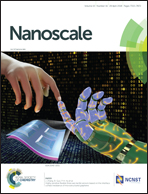Real-time monitoring of the Trojan-horse effect of silver nanoparticles by using a genetically encoded fluorescent cell sensor†
Abstract
Silver nanoparticles (AgNPs) are widely incorporated into commercial products due to their antimicrobial properties. As a consequence, concerns about the adverse effects induced by AgNPs to humans and the environment need to be carefully examined. The existing literature reveals that AgNPs exhibit certain toxic effects, but it remains to be proved whether AgNPs or the ionic silver (Ag+) released from AgNPs are the main toxic species. Here, a genetically encoded fluorescent protein sensor with high affinity to Ag+ was developed. The resulting sensor, MT2a-FRET, was found to be ratiometric, sensitive and selective toward only Ag+ but inert against AgNPs. This makes this sensor a potential useful tool for monitoring the real-time intracellular dissolutions of AgNPs. Our data supported that AgNPs display the “Trojan-horse” mechanism, where AgNPs are internalized by cells and undergo dissolution intracellularly. We further found that cells exhibited a detoxification ability to remove active Ag+ from cells in 48 hours.



 Please wait while we load your content...
Please wait while we load your content...